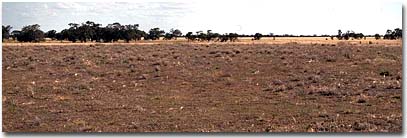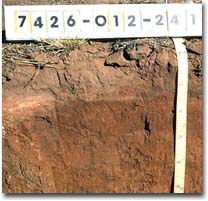Site WP3
Location: Morton Plains.
Australian Soil Classification: Calcic, Mesonatric, Red SODOSOL.
Northcote Factual Key: Dy 2.13.
Great Soil Group: red-brown earth.
General Landscape Description: Upper slope of a rise on a gently undulating plain.
 Site WP3 Landscape |
Soil Profile Morphology:
Surface Soil
| A1 | 0-15 cm | Strong brown (7.5YR4/6); light sandy loam; hardsetting and massive; firm consistence dry; pH 6.6; sharp change to: |  Site WP3 Profile |
| Subsoil | |||
| B21 | 15-30 cm | Yellowish red (5YR5/6); light medium clay (sandy); moderate prismatic structure (shiny faced peds); weak consistence; moderately moist; pH 8.5; gradual change to: | |
| B22 | 30-70 cm | Yellowish red (5YR5/6); medium clay; strong prismatic structure; firm consistence moderately moist; pH 9.2; clear change to: | |
| B3k | 70 -160 cm | Strong brown (7.5YR5/8); medium clay, sandy; prismatic structure; strong consistence dry; soft carbonate common (10-20%); pH 9.6. |
Soil Profile Characteristics:
pH | Salinity | |||
Surface (A1 horizon) | slightly acid | very low | non-sodic | - |
Subsoil (B21 horizon) | moderately alkaline | very low | strongly sodic | strong |
Deeper subsoil (at 1 m) | extremely alkaline | high | very strongly sodic | slight1 |

Horizon | Horizon Depth (cm) | pH (water) | pH (CaCl2) | EC 1:5 | Exchangeable Cations | NaCl % | Field Capacity pF 2.5 | Wilting Point pF 4.2 | |||
Ca | Mg | K | Na | ||||||||
meq/100g | |||||||||||
A1 | 0-15 | 6.6 | 5.8 | 0.3 | 2.1 | 0.7 | 0.3 | <0.1 | 2 | 5 | |
B21 | 15-30 | 8.5 | 7.2 | 0.1 | 5.7 | 5.4 | 0.7 | 2.3 | 28 | 12 | |
B22 | 30-70 | 9.2 | 8.5 | 0.84 | 5.2 | 8.2 | 1.2 | 5.3 | 0.14 | 33 | 15 |
B3k | 70-160 | 9.6 | 8.9 | 0.94 | 3.2 | 8.0 | 1.4 | 7.3 | 0.15 | ||
Management Considerations:
- Management strategies for all soils should aim to increase organic matter levels in the surface soil; minimise the degradation of soil aggregates and porosity; promote the development of stable biopores; improve the calcium status of the cation exchange complex (particularly when sodium is a significant part), and break up any hardpans. Less frequent tillage; using less aggressive implements, and working the soil at optimum moisture content can all assist in maintaining soil aggregation and porosity as well as reducing the breakdown of organic matter.
- The hardsetting surface condition can be improved by using management practises such as minimum tillage, stubble retention and pasture rotations to improve organic matter levels. The organic carbon level measured at this pit site is quite low.
- The surface soil has a low inherent nutrient status which can be improved by increasing organic matter levels.
- The water holding capacity of the surface soil is low. However, the low wilting point (5) value indicates that plants will be able to utilise light rains when the soil is relatively dry.
- The upper subsoil is moderately alkaline (becoming very strongly alkaline with depth). This indicates that certain nutrients such as iron, manganese, zinc and boron may be poorly available to plants.
- The upper subsoil is strongly sodic and dispersive. This will result in root and water movement being significantly restricted. Sodic subsoils can also create adverse nutrient balances and may even have toxic effects on some plants.
- The level of soluble salts becomes high in the deeper subsoil (below 30 cm depth). This is likely to restrict the growth of salt-sensitive species.


